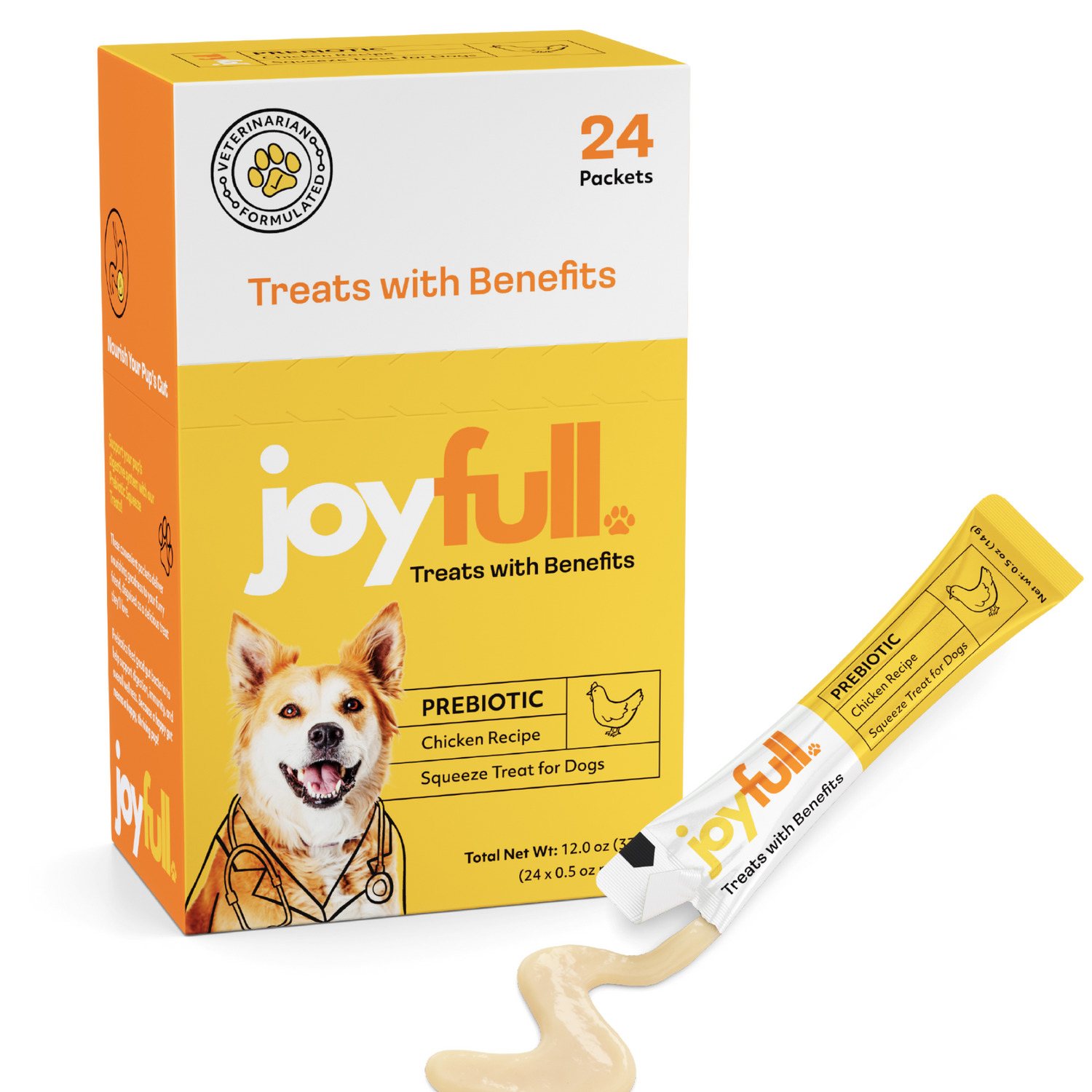
Ingredients to Avoid in Dog Food for a Healthier Pet
Ever felt like you need a secret decoder ring just to understand what's in your dog's food? You're not alone. The labels can be baffling, filled with jargon and marketing fluff.
But here’s a pro tip that cuts right through the confusion: focus on the first five ingredients. That's it. Legally, ingredients must be listed in descending order by weight, so these first few items tell you exactly what makes up the majority of your dog's meal.
How to Decode Your Dog's Food Label
Think of the ingredient list as the food's blueprint. The first five ingredients reveal whether it's built on a solid foundation of quality nutrition or stuffed with cheap fillers.
The absolute best thing you can see at the top of that list is a named animal protein. I'm talking about specific, clear terms like "deboned chicken," "beef," or "lamb meal." When a company is this specific, it’s a great sign of transparency and quality.
Spotting Red Flags Instantly
On the flip side, vague and generic terms should set off alarm bells. If you spot phrases like "meat meal" or "animal by-products" leading the charge, it’s time to be skeptical. These mystery meats could come from anywhere and are often a tell-tale sign of lower-quality, less nutritious sources.
Want to get even better at this? We break it all down in our guide on how to read dog food labels.
The ingredient panel is the only place a company must tell the truth. While the front of the bag sells a story with pictures of roasted chicken, the back of the bag reveals the facts.
This handy infographic breaks down the decision-making process, helping you quickly size up those crucial first ingredients.
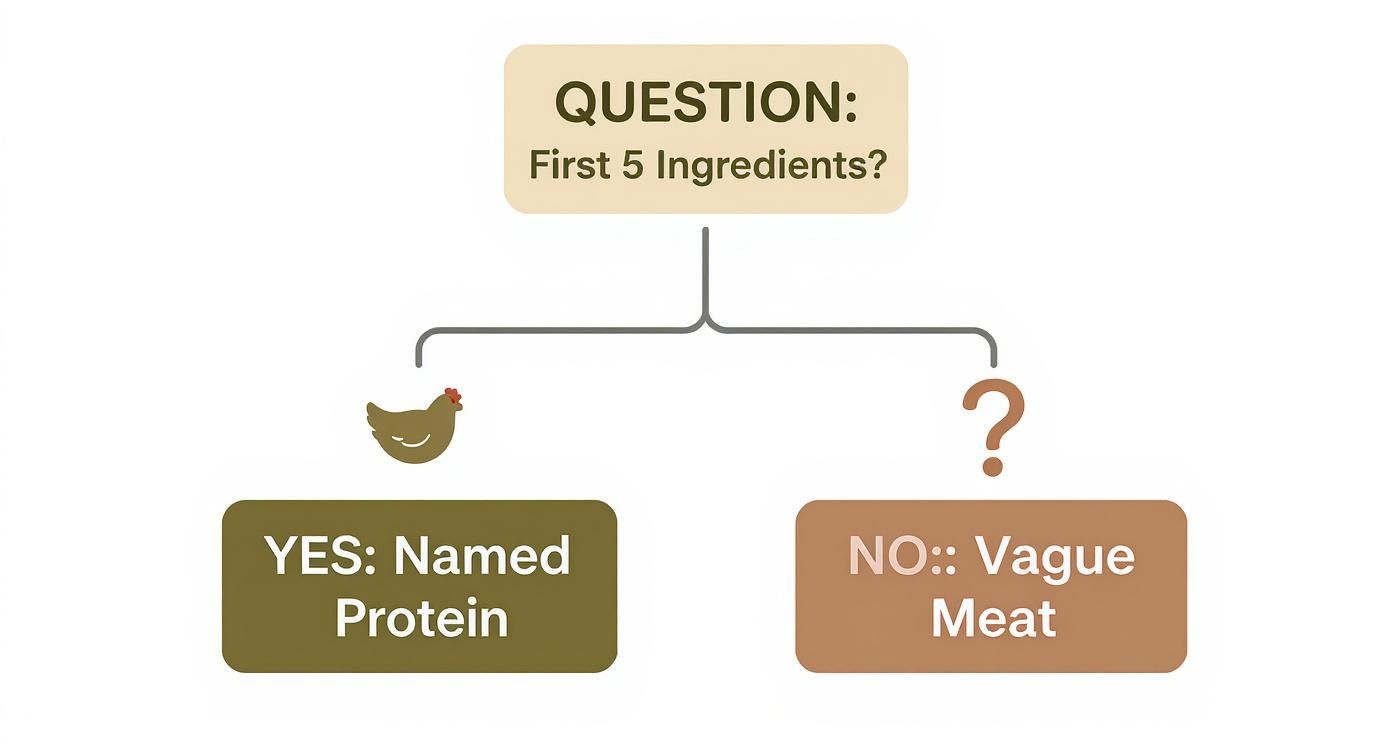
As you can see, the very first checkpoint is simple: is it a specific, named protein, or something vague and generic? Answering that one question is often the biggest clue to the food's overall quality.
Top 5 Risky Ingredient Categories at a Glance
To make it even easier, here's a quick cheat sheet of the most common red-flag ingredient categories you'll encounter. Think of this as your quick-scan guide for spotting trouble before it ends up in your dog's bowl.
| Ingredient Category | Common Examples | Primary Health Risk |
|---|---|---|
| Artificial Preservatives | BHA, BHT, Ethoxyquin | Potential links to cancer, organ damage, and allergic reactions. |
| Generic Protein Sources | Meat Meal, Animal By-Products | Unknown origin and quality, often from less nutritious parts. |
| Artificial Colors | Blue 2, Red 40, Yellow 5 & 6 | Unnecessary additives linked to hyperactivity and allergic reactions. |
| Artificial Flavors | Animal Digest, "Flavor" | Can hide low-quality ingredients and cause digestive upset. |
| Cheap Fillers | Corn, Wheat, Soy | Common allergens offering low nutritional value; can lead to obesity. |
Keeping an eye out for these five categories will help you quickly filter out the bad stuff and focus on formulas that are truly built for your dog's health.
The Problem with Artificial Preservatives and Dyes
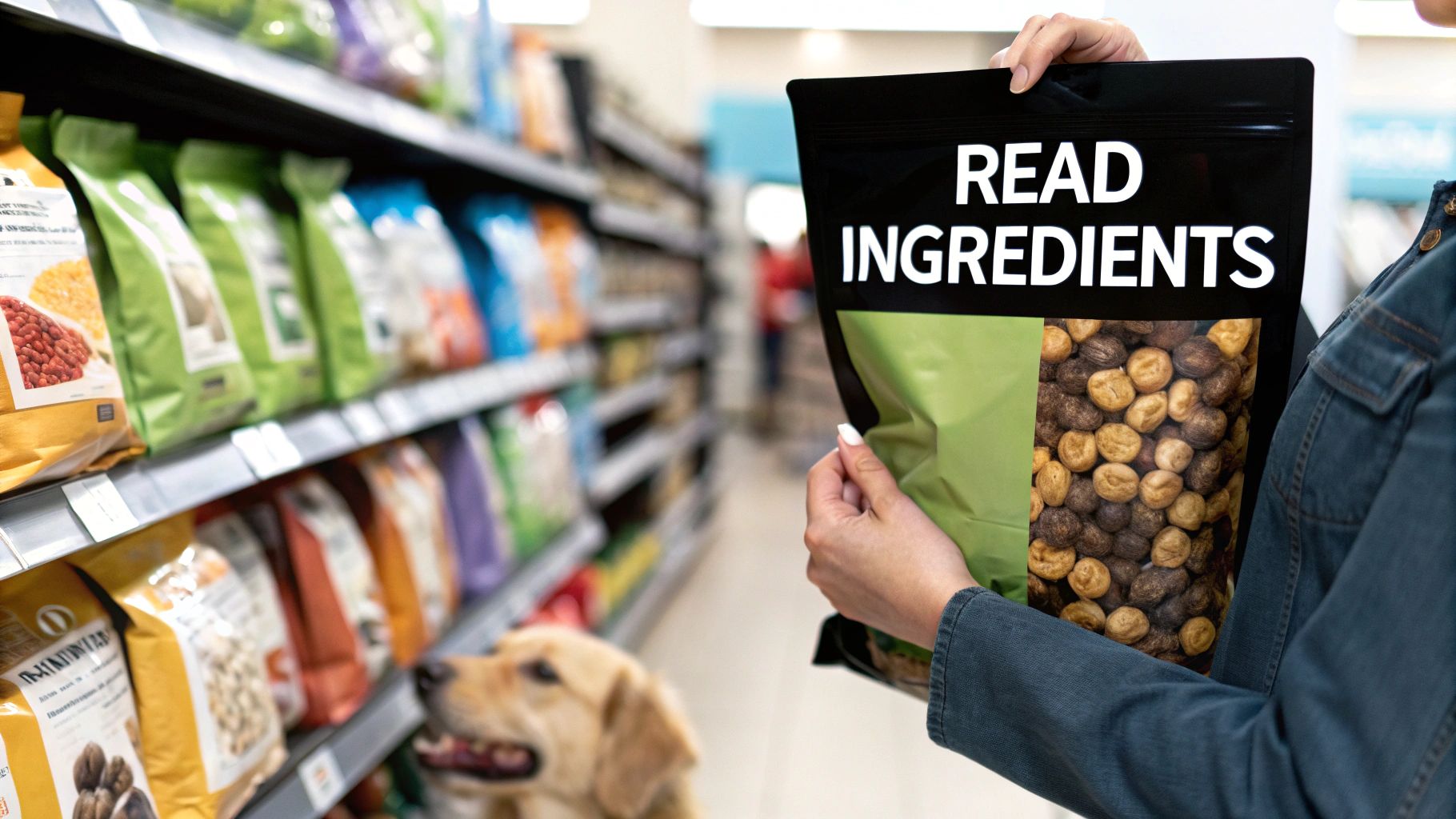
A long shelf life is great for manufacturers, and many dog foods achieve this by using artificial preservatives to keep fats from going rancid. But while that sounds practical on the surface, it often comes at a cost to your dog’s health.
Think about how you keep your own food fresh. You probably use a refrigerator or maybe natural methods like freezing or canning. You wouldn't spray your leftovers with industrial chemicals, right? Unfortunately, that’s not far from what’s happening in some bags of dog food.
The Risky Chemicals Hiding in Plain Sight
When you scan an ingredient label, three of the most notorious artificial preservatives to watch out for are BHA (Butylated Hydroxyanisole), BHT (Butylated Hydroxytoluene), and Ethoxyquin. These chemicals are masters at stabilizing fats, which is precisely why they're so common in mass-produced, lower-quality pet foods.
The safety of these ingredients, however, is a huge point of debate.
Take BHA, for example. The FDA permits its use in pet food, yet it’s been classified as a carcinogen because it has consistently caused tumors in lab animals. Then there's Ethoxyquin, a chemical originally developed as a pesticide. It's banned from human food but still legally finds its way into pet food, often used to preserve fish meal before it even gets to the dog food factory.
Thankfully, there are much better, safer ways to keep dog food fresh. Quality brands have already made the switch to natural options. You can learn all about safer alternatives like tocopherols (a form of Vitamin E) and rosemary extract in our guide to natural dog food preservatives.
When you spot BHA, BHT, or Ethoxyquin on a dog food label, it’s a major red flag. This often signals that the brand is prioritizing a long shelf life and lower costs over your dog’s long-term health.
Why Are There Colors in Kibble?
Ever notice how some kibble comes in a rainbow of reds, greens, and yellows? Here's a secret: it’s not for your dog. A dog’s world is one of scent and taste; they see a limited color spectrum and couldn't care less what their dinner looks like.
Those artificial colors are added for one reason and one reason only—to appeal to you, the human buying the food. The goal is to make a bag of brown kibble look more interesting and "nutritious."
Keep an eye out for these common culprits:
- Red 40
- Yellow 5 & 6
- Blue 2
These dyes add zero nutritional value and have been linked to hyperactivity and allergic reactions in some dogs. Their sole purpose is marketing. A dog food’s natural color, which is usually just a plain shade of brown, is a good sign—it reflects the real ingredients inside without any pointless chemical additives.
Why Vague Meat Ingredients Are a Major Red Flag
Protein is the absolute foundation of a healthy diet for your dog. But here’s the catch: not all protein is created equal. When you're standing in the pet food aisle, the most important thing you can do is play detective with that ingredient list. Specificity is everything.
Think of it this way. If you went to a restaurant and the menu just said "meat dinner," you'd have some serious questions, right? What kind of meat? Where's it from? You wouldn't settle for that for your own meal, so you shouldn't for your dog's, either. This is exactly why those generic terms are some of the biggest ingredients to avoid in dog food.
Decoding Mystery Meats
When you see vague, non-specific terms like "meat meal," "animal by-products," or "animal fat," your alarm bells should be ringing. These aren't just lazy descriptions; they're giant red flags signaling a serious lack of transparency and quality. These terms are used intentionally, giving manufacturers a legal loophole to use a rendered mix of animal parts from sources you'd probably rather not know about.
So, what can legally be tossed into these mystery meat concoctions? The truth is pretty unsettling. These ingredients often come from what the industry calls "4D" animals (dead, dying, diseased, or disabled) before processing. They can also include roadkill and, in some documented cases, even euthanized animals. The protein you get from these sources is wildly inconsistent and a far cry from the quality of a named meat.
A vague protein description like "meat meal" can be a catch-all for rendered products from any number of animals. It often includes parts that are completely unfit for human consumption, creating a traceability nightmare and a major risk to your pet's long-term health.
Spotting Quality Protein Sources
On the flip side, brands that use high-quality ingredients are proud of it—and they'll shout it from the rooftops on their labels. Your goal is to find a food where the first few ingredients are specific, identifiable, and sound like real food.
Here’s a simple cheat sheet to help you sort the good from the questionable:
-
Avoid This: "Meat Meal" or "Animal Meal"
-
Look For This: "Chicken Meal," "Beef Meal," or "Lamb Meal"
-
Avoid This: "Animal By-Products"
-
Look For This: "Chicken Liver" or "Beef Heart" (specific, nutrient-dense organs)
-
Avoid This: "Animal Fat"
-
Look For This: "Chicken Fat" or "Sunflower Oil"
When you choose a food that lists deboned chicken or beef meal right at the top, you know exactly what your dog is eating. This isn't just about quality; it’s also crucial for managing any potential food allergies or sensitivities. By becoming a savvy label-reader, you're making sure your dog's diet is built on a foundation that's wholesome, identifiable, and genuinely nutritious.
Uncovering Hidden Sweeteners And Fillers
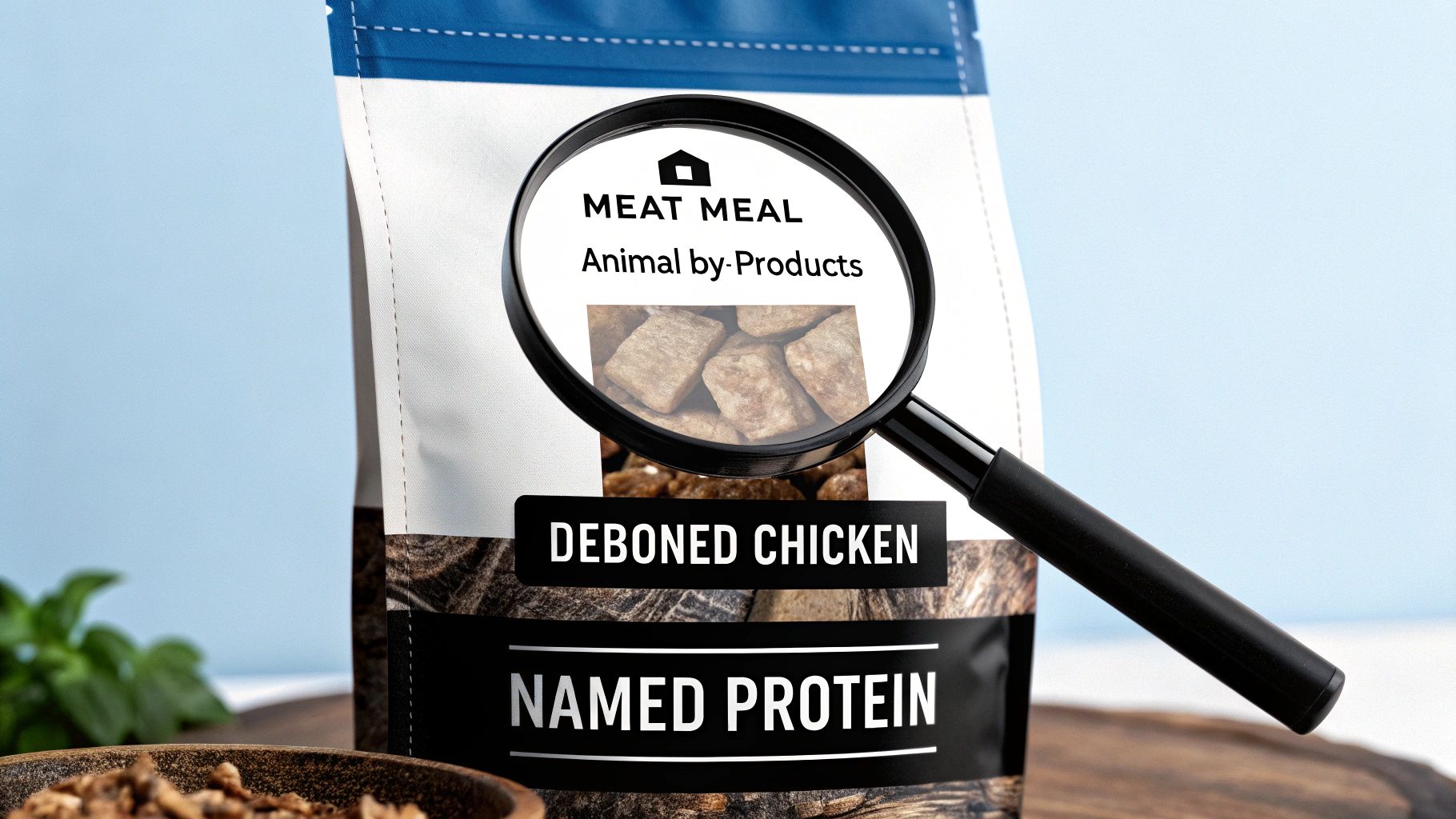
While the quality of the protein source is a huge piece of the puzzle, a whole other category of sneaky ingredients deserves our attention: sweeteners and fillers. It might surprise you, but dogs have absolutely no nutritional need for sugar. So why is it in their food? Often, it’s a cheap trick to make an otherwise bland, low-quality meal more appealing to them.
Additives like corn syrup, sucrose, and fructose send a dog's blood sugar on a wild rollercoaster ride. Over time, these constant spikes and crashes can lead to unnecessary weight gain, painful dental problems, and even set the stage for serious health issues like diabetes.
The Dangers Lurking In Sweeteners
Not all sweeteners carry the same risk, and some are downright deadly. The one you must always scan for is xylitol, an artificial sweetener that is extremely toxic to dogs.
Even a minuscule amount of xylitol can cause a massive, rapid release of insulin, making your dog's blood sugar plummet to life-threatening levels. This condition, known as hypoglycemia, can quickly lead to seizures, liver failure, and death.
Other sweeteners, like high-fructose corn syrup, aren't immediately toxic but pose long-term risks. They contribute to insulin resistance, obesity, and an increased risk of diabetes down the road. It’s simply not worth it.
Why Fillers Dilute Nutrition
Beyond the sweet stuff, many budget-friendly dog foods are bulked up with cheap fillers. These ingredients add weight and volume to the bag for a very low cost, but they offer next to no real nutritional value. Think of them as empty calories for your dog—they'll make them feel full without providing any of the good stuff their body actually needs.
Here are a few of the most common fillers to keep an eye out for:
- Corn & Corn Gluten Meal: A cheap, low-grade protein substitute that many dogs find difficult to digest. It’s also a frequent trigger for allergies.
- Wheat Gluten: Another inexpensive plant protein that’s often linked to digestive upset and itchy skin in sensitive pups.
- Soy: While technically a complete protein, soy is another major allergen for dogs and can sometimes interfere with proper thyroid function.
Choosing a food packed with fillers is like trying to build a strong house with cardboard instead of bricks. It might look complete from the outside, but it lacks the structural integrity needed for long-term health and strength.
When a food is full of these ingredients, there's less room for the things your dog truly needs, like high-quality animal proteins, healthy fats, and nutrient-rich vegetables. Learning how to spot and sidestep these fillers is a crucial step in giving your dog a genuinely nourishing diet.
To dive deeper into this, check out our guide on selecting a quality dog food without fillers.
When you're scanning an ingredient label, it helps to know what to avoid and what to look for instead. Here’s a quick-reference table to help you make smarter choices.
Harmful Additive vs. Healthy Alternative
| Harmful Ingredient | Potential Health Risk | Safer Alternative |
|---|---|---|
| Xylitol, Corn Syrup | Toxicity, hypoglycemia, obesity, diabetes | None needed. Sweetness can come from natural ingredients like sweet potato or carrots. |
| BHA, BHT, Ethoxyquin | Potential carcinogens, liver & kidney damage | Mixed Tocopherols (Vitamin E), Rosemary Extract |
| Artificial Colors | Linked to hyperactivity and allergic reactions | Natural sources like beet powder or turmeric for color. |
| Propylene Glycol | Can be toxic in high doses; a less-safe preservative | Vegetable Glycerin or naturally preserved foods. |
| Corn, Wheat, Soy | Common allergens, poor digestibility, low nutritional value | Whole Grains (oats, brown rice) or grain-free options (sweet potatoes, peas). |
By keeping an eye out for these harmful additives and prioritizing foods with wholesome, natural alternatives, you're making a huge investment in your dog's long-term health and happiness.
The Unseen Threat of Toxic Heavy Metals
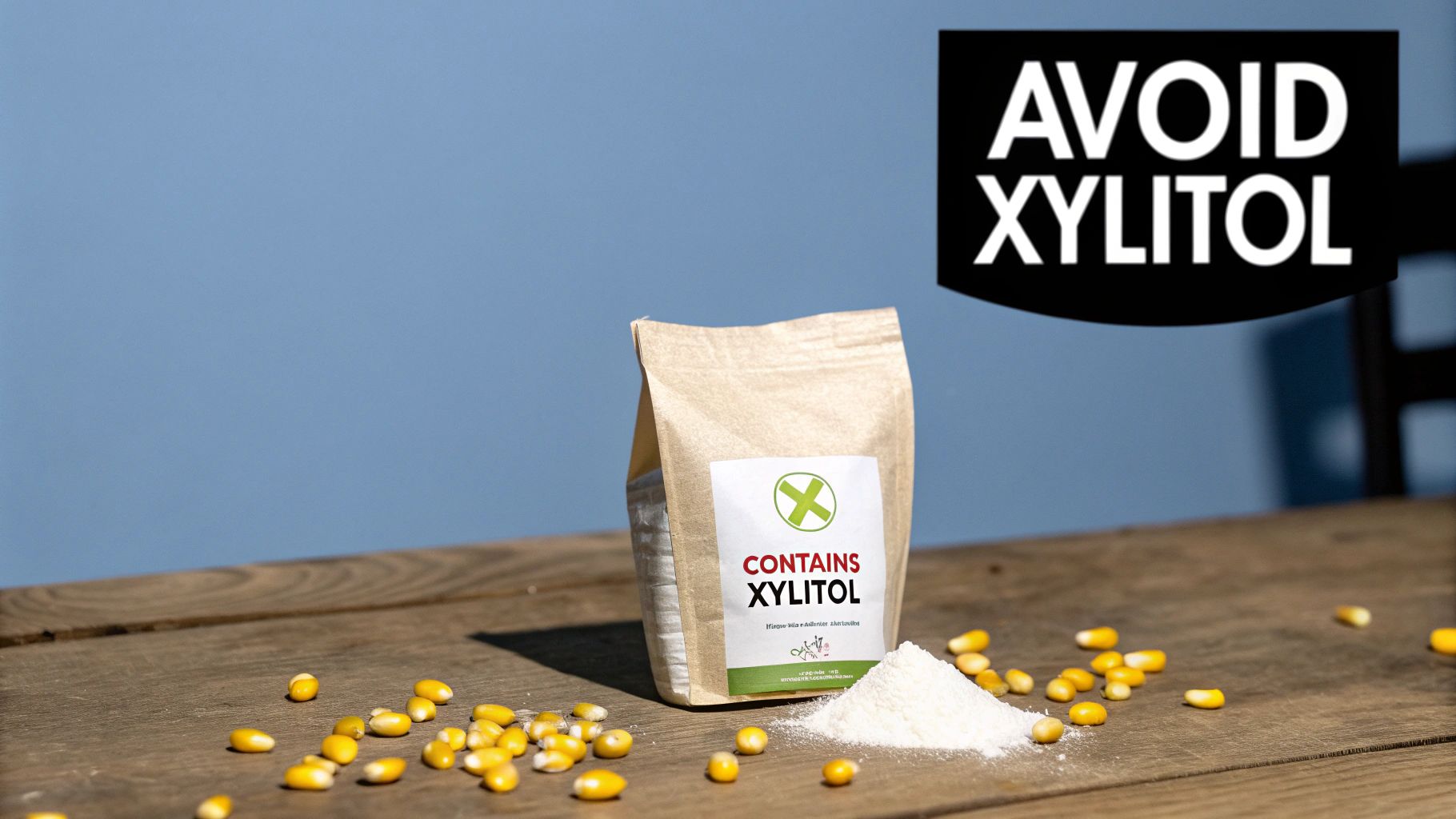
When we scan a dog food label, we're usually looking for fillers or weird-sounding chemicals. But some of the most dangerous ingredients aren’t even listed. A silent threat can be hiding in your dog's bowl: toxic heavy metals like lead, mercury, and arsenic.
These contaminants don't get added on purpose. They sneak into the food supply through cheap, low-grade raw materials, especially rendered protein meals from questionable sources. Over time, these toxins can build up in your dog’s body, causing slow-motion damage.
How Contamination Builds Up
Imagine your dog's body is like a high-tech filter. When a tiny amount of a toxin comes through, the system works hard to clear it out. But if their food delivers a steady, low dose of heavy metals day after day, that filter gets overwhelmed. It simply can't keep up.
This slow buildup is a process called bioaccumulation, and it's what makes heavy metals so sneaky and dangerous. A single meal won't cause an issue, but months or years of constant exposure can lead to serious, chronic health problems that are incredibly hard to trace back to the food.
The toxins get stored in vital organs, eventually triggering a range of issues that can be devastating for your dog.
- Neurological damage
- Kidney or liver failure
- Chronic digestive problems
- A general decline in health and vitality
This gradual poisoning is precisely why choosing a brand that’s transparent about its sourcing is so important.
The Link to Low-Quality Protein
The risk of contamination is directly connected to the quality of the ingredients. In one eye-opening analysis, a shocking 80.55% of dog foods were found to exceed the maximum tolerated levels for lead.
The study pinpointed that certain protein meals—like beef meal, chicken by-product meal, and fish meal—are often the culprits. For instance, some beef meal samples had lead levels more than double the acceptable limit. That's a huge red flag, especially since lead is tied to neurological disorders and severe gastrointestinal issues in dogs. You can dig into the full report on heavy metals in pet food and their health implications to see the data for yourself.
To keep your dog safe, the best defense is a good offense. Look for companies that are upfront about where their ingredients come from. Even better, find brands that use third-party testing to screen for these invisible toxins. Choosing a food made with high-quality, clean ingredients is one of the most powerful things you can do to protect your dog from these hidden dangers.
Finding a Better Food for Your Dog
You’ve done the hard part—learning which ingredients to steer clear of. That’s a massive step. Now, let's talk about the good stuff and what you actually should be looking for on the label.
Finding a top-notch food isn't about chasing some mythical "perfect" brand. It's about recognizing the hallmarks of a quality diet that puts your dog's health first, not the manufacturer's bottom line.
A great place to start is exactly where we began: the first few ingredients. You want to see a named, whole-food protein source right at the top. Think "deboned chicken," "grass-fed beef," or "wild-caught salmon." This isn't just marketing—it's a sign of transparency and a solid nutritional foundation.
After the protein, glance at the rest of the list. Are you seeing whole foods you recognize, like sweet potatoes, peas, and blueberries? Or is it a long, confusing list of cheap fillers and fractions? A simple, clean ingredient deck is almost always a good sign.
How to Switch Foods Without Upsetting Their Tummy
So you've picked out a fantastic new food. Great! But hold on—don't just swap it out all at once. A sudden change can wreak havoc on your dog's digestive system, leading to vomiting or diarrhea. A slow, gradual transition is the secret to a happy gut.
Here’s a simple, vet-approved seven-day plan to make the switch seamless:
- Days 1-2: Mix 75% old food with 25% new food.
- Days 3-4: Go half and half with a 50/50 mix.
- Days 5-6: Tip the scales to 25% old food and 75% new food.
- Day 7: You’ve made it! Serve 100% of the new food.
This gentle introduction gives their digestive system plenty of time to get used to the new ingredients and nutrient levels.
By choosing wisely and transitioning carefully, you're doing more than just changing their dinner. You're making a real, long-term investment in their health and happiness.
At the end of the day, the goal is to find a food that’s free from all those red flags we talked about—no artificial preservatives, no mystery meat meals, and no cheap, empty fillers. When you know what to look for, you can cut through the marketing noise and confidently choose a diet that will help your best friend thrive.
Common Questions About Dog Food Ingredients
Trying to decipher a dog food label can feel like a pop quiz you didn't study for. Even when you're trying to do the right thing for your pup, the industry's jargon can leave you with more questions than answers. Let's tackle some of the most common points of confusion.
Are All By-Products in Dog Food Bad?
This is a tricky one. Technically, not all by-products are bad, but the vague labeling is a huge red flag. A term like "chicken by-products," for example, could include incredibly nutritious organ meats like liver and heart. But it could also mean low-quality, indigestible parts like beaks, feet, and feathers that offer next to no nutritional value.
The real problem here is the lack of transparency. A good dog food company will be proud to list exactly what's inside, like "chicken liver" or "beef heart." When you see a generic term like "animal by-products," it's a safe bet to just walk away. The source is a mystery, which usually means it's not something you'd want to feed your dog.
Is a Grain-Free Diet Always Healthier?
Not necessarily. The grain-free trend took off because so many brands were using cheap, low-nutrient fillers like corn and wheat, which are also common allergens. The problem is, many grain-free foods just swapped those out for other starchy fillers, like potatoes or peas, which can create their own set of issues.
Some dogs do wonderfully with healthy, whole grains like brown rice, quinoa, or oats. The most important thing isn't whether a food has grains, but the overall quality of every single ingredient in the bag.
Always chat with your veterinarian before making a big dietary change. It's especially important given the ongoing investigation into potential links between certain grain-free formulas and a canine heart condition known as DCM.
What Are Natural Flavors and Should I Avoid Them?
"Natural flavors" is an officially regulated term for any flavor derived from a plant or animal. While it might sound innocent, it's often a proprietary flavor blend sprayed onto kibble to make low-quality, bland food more appealing to dogs.
Think about it: if the main ingredients were high-quality and tasty on their own, would they need an artificial boost? The presence of "natural flavors" is often a signal that the core ingredients aren't very appetizing, and it keeps you from knowing what’s really in that flavor mix.
At Joyfull, we don't believe in hiding behind confusing terms. We use high-quality, whole-food ingredients that are naturally delicious—no mystery "flavors" needed. You can see our commitment to clean, beneficial formulas at https://joyfullpet.com.
